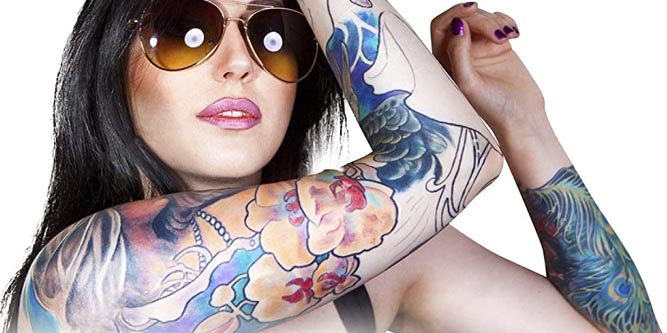If you’re preparing for a tattoo, planning is critical. You only get one chance to get things right, so creating a stencil is the key to perfection. This is true even in the case of temporary or henna tattoos. People often get these tattoos for special occasions. They might be temporary, but the wedding pictures are as permanent as any ordinary tattoo. Once again, if you want everything to go smoothly, it’s important to have a stencil.
Printing a good stencil is not the same as printing a good photograph. A good photo printer, for example, will be optimized for maximum color richness and resolution. If it runs slower than an ordinary document printer, that’s just fine. A good stencil printer, on the other hand, should be easy and quick to use. If you’re drafting ideas by hand and printing them out, you want to be able to do it quickly. We’ve reviewed several unique printer types in the past, such as edible ink printers for cakes. Now, it’s time to try our hand at some dot matrix tattoo transfer stencil printers.
A dot matrix printer works by moving a mechanical print head over a membrane. The membrane has a pattern of holes (a “dot matrix”) that allows ink to bleed through. On a thermal printer, the process is similar, but with heat bleeding through instead of ink. The advantage of this printing method is that it’s very fast. The downside is that it’s not especially high-resolution. But with modern technology, even a “low-resolution” dot matrix printer is finer than a set of tattoo needles. As a result, it’s high-enough resolution for tattooing.
We’ll start by reviewing the BMX Tattoo Stencil Transfer Machine. This is a small desktop printer designed to use thermal paper. Next, we’ll look at the Oki 62418701 MICROLINE 420 Dot Matrix Printer. This is a beefier, high-capacity printer that can be used to print large numbers of drafts very quickly. Finally, we’ll examine the ZJchao Tattoo Transfer Stencil Machine. This is an ultralight, portable printer that can be carried in a laptop bag. Which one is the best? Let’s take a closer look at the features, and see what we uncover!
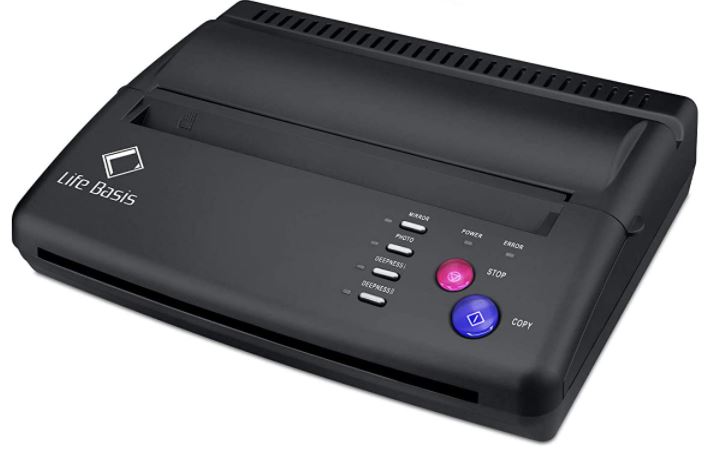
BMX Tattoo Stencil Transfer Machine
First up on our list is the BMX Tattoo Stencil Transfer Machine. This is a small desktop printer that measures a foot wide and about 10 inches deep. At under five inches thick, it’s fairly compact. Moreover, the total weight is only 4.85 pounds, so it’s easy to relocate as needed. Much of the small weight and size is due to the fact that this is a thermal printer. It uses A4 or A5 thermal transfer paper, not ordinary printer paper. This means that the paper is a bit pricier. However, since you don’t have to buy ink, the overall operating cost is actually lower than an ordinary ink printer.
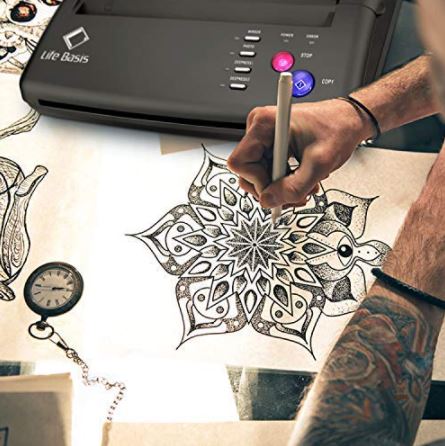
The printer housing is all black, with curved edges that give it a stylish appearance. There’s a feeder slot on top, with the output slot on the front. You feed one sheet at a time, but the alternative would be a much larger design with a paper tray. On the top of the unit, beneath the feeder slot, you’ll find all the controls. They’re big, they’re rubbery, and they’re clearly marked. You shouldn’t have any trouble with everyday operation. If you do, the BMX Machine is protected by a 12-month manufacturer’s warranty. If you have any serious problems, simply file a claim for a refund or replacement.
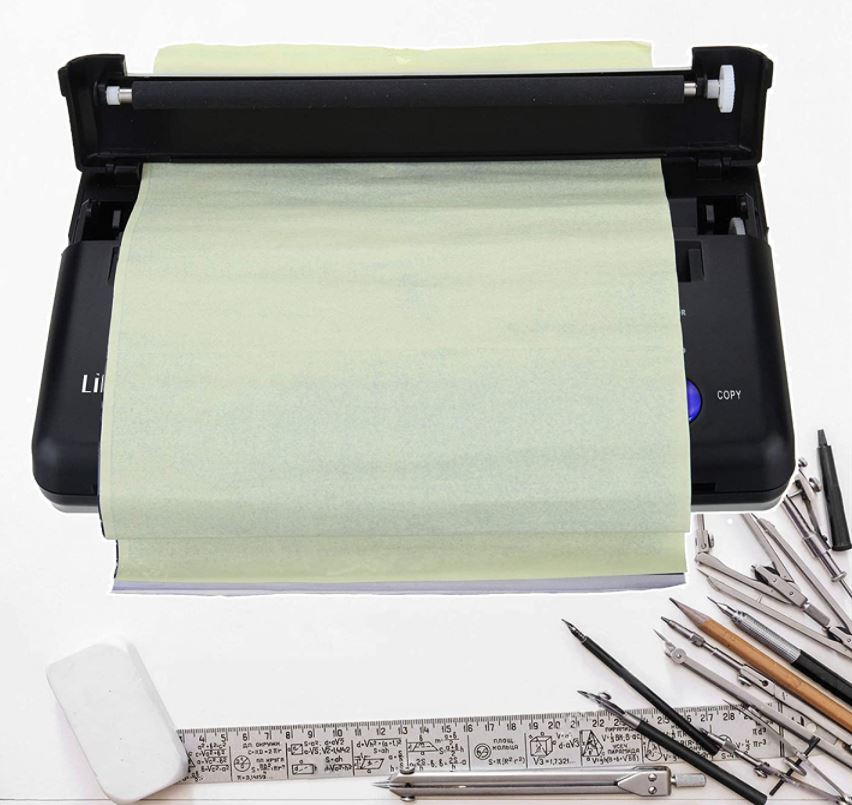
Connectivity and Setup
The BMX Tattoo Stencil Transfer Machine differs from traditional printers in another respect. It doesn’t connect to your computer or phone. There’s no USB or wireless input. Instead, it’s made for copying hand-drawn drafts. For this purpose, there are two color options. Normal copy simply burns a copy of your image into a sheet of thermal paper. Mirror copy does the same thing, but reverses the image. You can use mirror copy to create perfectly symmetrical images by copying one side twice. This can be incredibly useful once you’ve gotten a draft you like. It won’t save a poorly-drawn tattoo, but it can make the difference between “very good” and “perfect.”
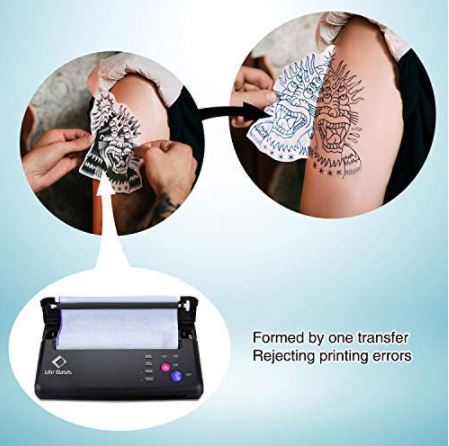
Print Quality
The BMX Machine has a resolution of 200 x 200 DPI. This is quite good, better than most dot matrix printers. Scan quality, meanwhile, is eight dots in a horizontal millimeter, with 7.7 lines per vertical millimeter. This works out to a resolution of just over 200 DPI. That’s more than the print resolution, so you shouldn’t experience any loss in quality during your image transfer.
Keep in mind that when we talk about good quality, we’re comparing apples to apples. The performance of the BMX printer is good for a dot matrix, and more than good enough for tattooing. That said, it only prints in black and white, and the resolution is far less than you want for photo printing. Even if you’re printing black and white photos, you should really use a dedicated photo printer. The same goes for the scanner quality. 200 x 200 DPI is very poor for a modern scanner, and should never be used for photos. However, that’s not necessary for tattoos. Remember, most tattoo needles are nowhere near that fine, so 200 DPI is more than good enough for tattooing purposes.
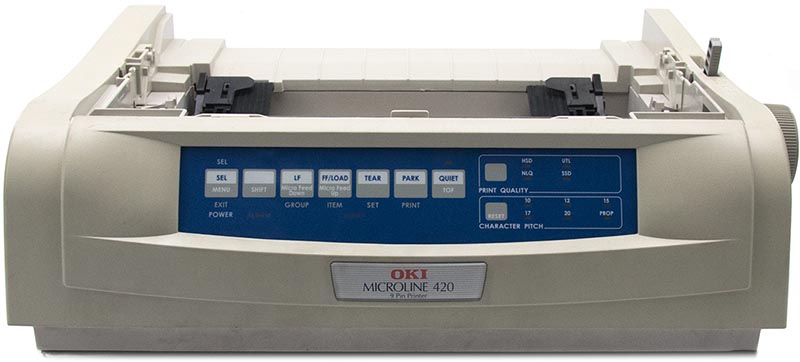
Oki 62418701 MICROLINE 420 Dot Matrix Printer
The Oki 62418701 MICROLINE 420 Dot Matrix Printer is a more traditional office printer. It’s built for high-capacity work, and has the beefy frame to match. It measures 20.76 inches wide, 21.5 inches deep, and 9.25 inch thick, and weighs 17 pounds. This makes it less portable than our other options, but also offers more capacity. It’s capable of printing over 570 characters per second, which works out to “very fast” in tattoo terms. It’s also covered by an impressive three-year warranty. Because of this quality, the MICROLINE 420 costs more than the BMX, but it’s money well spent.
Perhaps its most useful feature is the expandable head gap. This allows you to insert very thick material into the printer. You can print on cut-sheet stock, stiff index stock, and other “portfolio-grade” materials. You can also print on up to six-part forms for making multiple copies. This isn’t useful for actually applying tattoos. But it’s useful for drafting. Suppose you’re happy with part of a design, or you’re working with an existing tattoo that needs modifying. You can use multi-part paper to print multiple working copies simultaneously, which saves a lot of time.
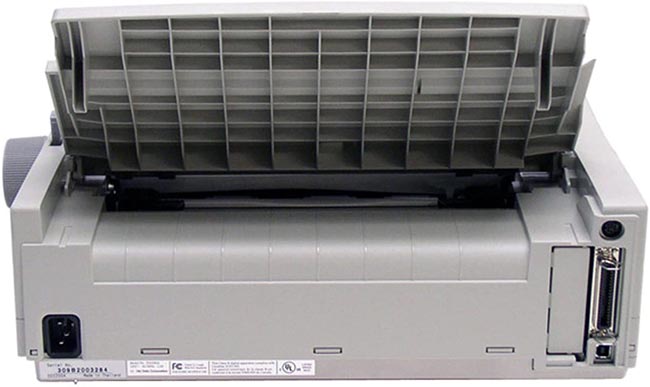
Connectivity and Setup
As a traditional printer, the MICROLINE 420 accepts a USB Type-B input. This can come from any device, although it’s easiest to work with a PC. There’s a USB Type-B cable included in the kit, so you don’t have to buy anything extra. In addition to that, there’s an old-school parallel port. These haven’t been standard on most hardware since the 1990s. However, some older point-of-sale systems still use a parallel output. This almost certainly won’t serve any purpose for tattooing, but it’s an unusual feature that’s worth pointing out.
Regardless, the net result is that you won’t be printing anything from hand-drawn drafts. At least, if you do, you’re going to need a separate scanner or a high-quality camera. But you can work with digital designs without needing to convert anything or buy another printer. The ability to print from a file is especially useful for coverups and modifications. You can take a picture of the original, then print working copies to draw over.
Print Quality
The MICROLINE 420 has a slightly higher resolution than the BMX printer. At 240 x 216 DPI, it far exceeds the majority of dot matrix printers on the market. That said, this is still a relative measurement. Remember, you’re printing tattoo stencils, not ultra-HD family photos.
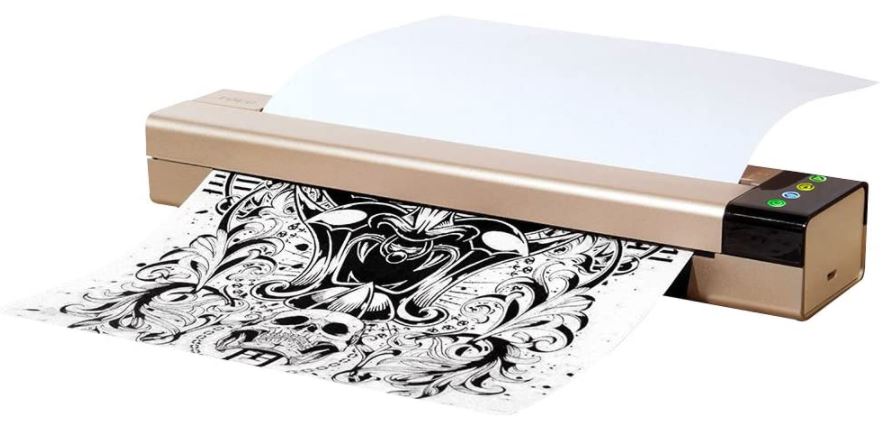
ZJchao Tattoo Transfer Stencil Machine
The ZJchao Tattoo Transfer Stencil Machine is engineered to be as compact and portable as possible. At 11.1 inches wide, 2.3 inches deep, and 1.5 inches thick, it can slip into a backpack or laptop bag. It also weighs just 19.2 ounces, so it’s lightweight enough to carry anywhere. The tan outer case is constructed from durable aluminum, and is designed to handle some bumps and bangs. It’s not “drop-proof,” but it’s not going to break just because you set your bag down too hard. Not only that, but it’s energy-efficient. If you don’t interact with it for three minutes, it will automatically go into sleep mode to conserve power.
It has a direct-feed design, with an input slot on the top. This allows you to feed size A4 and B4 thermal paper directly into the printer. The output slot is located on the front, as you’d expect from most printers. The controls are located on the top right, marked by colorful LEDs in a black soft-touch panel. Operation is simple and intuitive, and you’ll know everything you need to know in just a few minutes. Along with the printer itself, you get a USB data transfer cable, as well as a flash drive with installation software.
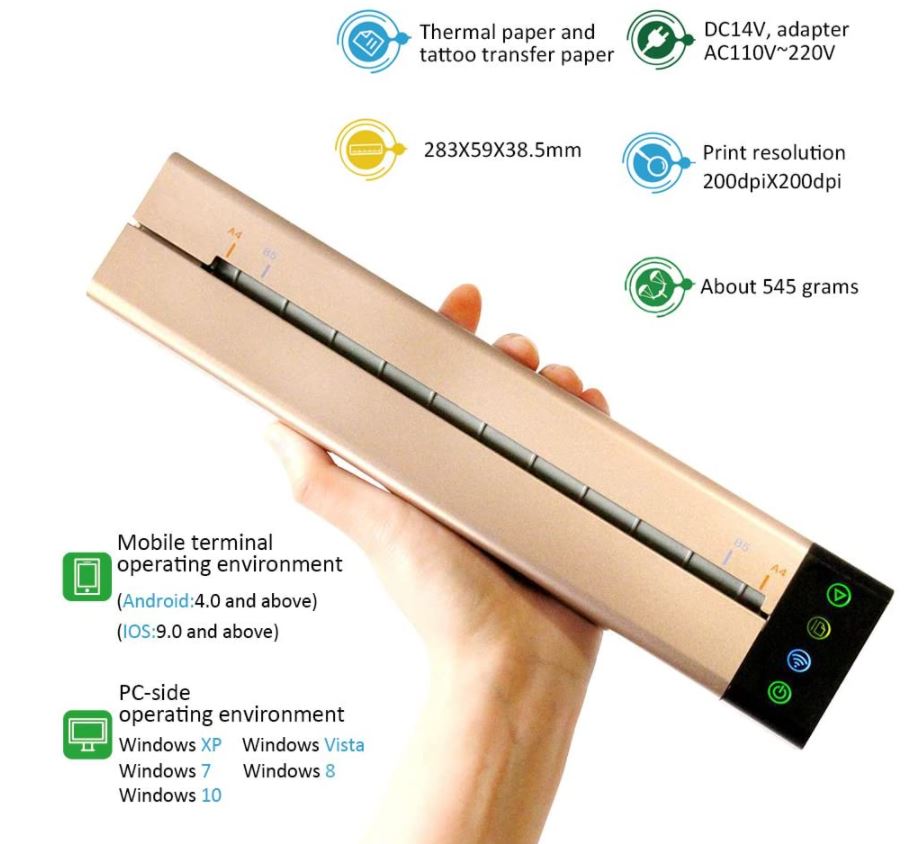
Connectivity and Setup
The ZJchao Tattoo Transfer Stencil Machine can connect via WiFi or USB. This makes it easy to print from your other devices. You can transfer an image from your favorite editing software, or even scan a hand-drawn draft. Before you get started, you’ll need to install the printer software. This software will install on iOS 9.0 or higher, or Android 4.0 or higher. On PC, you’ll be able to print from other apps, but compatibility may or may not be an issue. This is primarily a mobile printer, so PC support is limited.
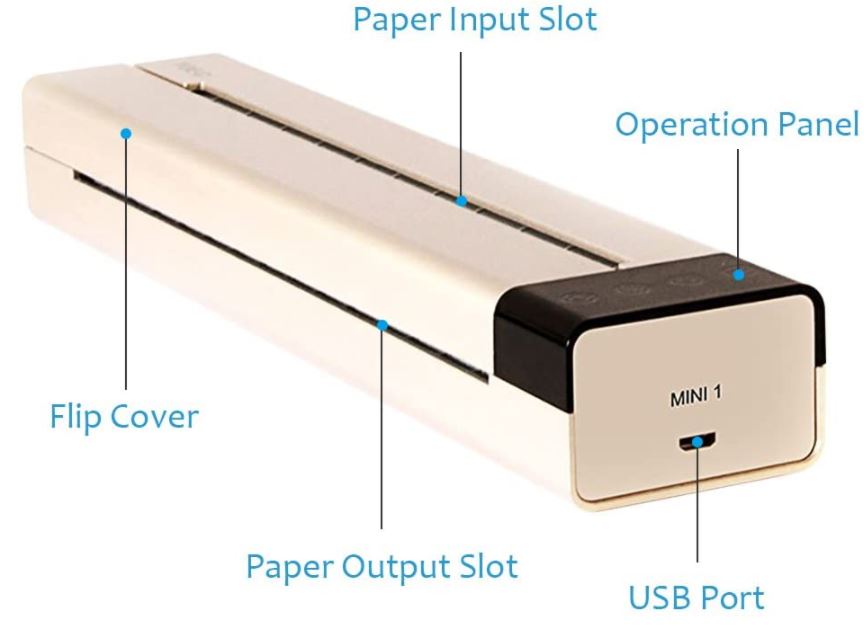
Print Quality
The ZJchao machine has a resolution of 200 x 200 DPI. This is right in line with the other printers we’ve looked at, and it’s just what you need for tattooing. In addition to ordinary thermal paper, it also supports tattoo transfer paper. This can be used to apply a stencil directly to the skin, or to create a custom temporary tattoo.
Final Verdict
Clearly, each of these printers has its own benefits and drawbacks. So, what have we learned? We started by reviewing the BMX Tattoo Stencil Transfer Machine. It’s a great desktop printer for making basic thermal paper transfers. However, the BMX machine also has a bit more to offer. The main added benefit is mirror mode, which allows you to make perfectly symmetrical images. This is a great tool to have on your desk or drafting table, or wherever you do your creative work. That said, it’s more of a copier than a printer, since there’s no way to print from any of your devices.
Second on our list was the Oki 62418701 MICROLINE 420 Dot Matrix Printer. This is a more traditional dot matrix paper, with a beefier design to match. It has a hopper tray, as well as an adjustable head gap that allows for up to six-part paper. This is a huge benefit when printing multiple copies. Not only that, but it connects to a phone or PC using a USB interface. This makes it easy to print a stencil from a digital draft. The main attraction, however, is the ability to print photos of existing tattoos. If you do a lot of coverups or touchups, the MICROLINE 420 is an excellent choice.
The ZJchao Tattoo Transfer Stencil Machine is your best choice if you’re on the road. It’s compact and lightweight, and it’s made specifically to print from mobile devices. In addition to that, it will print to tattoo transfer paper. This is a huge bonus if you want to apply a stencil directly or create a custom temporary tattoo. Combine these features with a respectable 200 x 200 DPI resolution, and you’re looking at a great selection.
Meet Ry, “TechGuru,” a 36-year-old technology enthusiast with a deep passion for tech innovations. With extensive experience, he specializes in gaming hardware and software, and has expertise in gadgets, custom PCs, and audio.
Besides writing about tech and reviewing new products, he enjoys traveling, hiking, and photography. Committed to keeping up with the latest industry trends, he aims to guide readers in making informed tech decisions.

